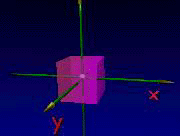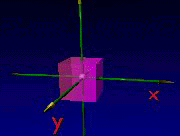This page is a
preview of some ideas from Ch 4.
A linear
transformation is a function from one vector
space to another (that obeys a few rules..). You saw very simple
examples in Calculus, such as the function f(x) = 2x. You can
check it obeys one of the rules - that f(0) = 0. It may surprise
you that f(x) = 2x + 1, for example, is not a linear
transformation. It doesn't obey this basic rule!
The first computer graphic shows the effect of
the transformation, f(x) = 2x. We say it stretches, scales, or dilates the
line. Click on your browser's refresh or reload button to watch
it again.
 The green bar in the picture
is the real line, the vector space R1. The silver ball
is the vector 0, which doesn't move. The short
yellow bar is the interval S = [-1,1]. After doubling all these
numbers, the interval grows to [-2,2]. This new set can be called
"f(S)".
The green bar in the picture
is the real line, the vector space R1. The silver ball
is the vector 0, which doesn't move. The short
yellow bar is the interval S = [-1,1]. After doubling all these
numbers, the interval grows to [-2,2]. This new set can be called
"f(S)".
Disclaimers: There is nothing special about the interval
[-1,1]. I just needed a second color besides green to show the
effect.
Also, the animation really shows a sequence of 11 different
pictures. But only the first and last pictures have any real
meaning in this example. Just the "before" and
"after" pictures would tell this simple story
pretty well.
 This example is similar,
but the transformation is from R3 to itself, and now
we'll call it L(x) = 2x. [Click
on reload again!]. The yellow interval has been replaced by a
pink cube. The corner nearest to us is the vector v
= [1,1,1], which moves to L(v) = [2,2,2]. The matrix representation of
L is the matrix "M" such that L(v) = Mv
[for all v.] Here M=2I, or
This example is similar,
but the transformation is from R3 to itself, and now
we'll call it L(x) = 2x. [Click
on reload again!]. The yellow interval has been replaced by a
pink cube. The corner nearest to us is the vector v
= [1,1,1], which moves to L(v) = [2,2,2]. The matrix representation of
L is the matrix "M" such that L(v) = Mv
[for all v.] Here M=2I, or
You can easily check that M[1,1,1] = [2,2,2] - as it should.
Matrices like M are used in most 3D computer graphics programs,
and you'll see linear algebra vocabulary even in 2D software like
Photoshop.
By the way, "3D graphics" has to be changed to
"2D graphics" before it can be put on paper or a
monitor. This is (approximately) a special kind of linear
transformation from R3 to R2, called a projection
operator (an "operator" is basically the same thing as
a "transformation").
 Reload again! This is a
picture of a rotation
operator. This one goes around the upward z-axis (or the "x3-axis").
This means, for example, that L(e3) = e3.
So, e3 is an eigenvector
of L, more on that in Ch 6!
Reload again! This is a
picture of a rotation
operator. This one goes around the upward z-axis (or the "x3-axis").
This means, for example, that L(e3) = e3.
So, e3 is an eigenvector
of L, more on that in Ch 6!
Let's find L's matrix, "M". Notice that e1
(on the x1- axis) swings around behind to -e2,
so M[1,0,0] must be [0,-1,0]T. But M[1,0,0] = the
first column of M. Likewise, the second column must be L(e2),
which is e1. The third column is L(e3) = e3.
So,
You may want to check that this works; that M e1 =
- e2, for example. Or (observing the nearest corner)
that M[1,1,1] = [1,-1,1]T. You might have noticed that
doing L four times takes us back to the start. That means
multiplying any v by M four times should have no
effect. So, M4 = I. Check this, too! See My Favorite Matrices for more examples like
M.
Of course, linear transformations are much more than this.
Most of them, such as the familiar derivative operator, L(f)=f ',
have little to do with 3D space. But if V has a finite basis, L
always has a matrix, which usually helps us understand L.
Read this over a few times, but don't assume that you know it
all yet! I haven't scratched the surface!
Back to the Help page
 The green bar in the picture
is the real line, the vector space R1. The silver ball
is the vector 0, which doesn't move. The short
yellow bar is the interval S = [-1,1]. After doubling all these
numbers, the interval grows to [-2,2]. This new set can be called
"f(S)".
The green bar in the picture
is the real line, the vector space R1. The silver ball
is the vector 0, which doesn't move. The short
yellow bar is the interval S = [-1,1]. After doubling all these
numbers, the interval grows to [-2,2]. This new set can be called
"f(S)".  This example is similar,
but the transformation is from R3 to itself, and now
we'll call it L(x) = 2x. [Click
on reload again!]. The yellow interval has been replaced by a
pink cube. The corner nearest to us is the vector v
= [1,1,1], which moves to L(v) = [2,2,2]. The matrix representation of
L is the matrix "M" such that L(v) = Mv
[for all v.] Here M=2I, or
This example is similar,
but the transformation is from R3 to itself, and now
we'll call it L(x) = 2x. [Click
on reload again!]. The yellow interval has been replaced by a
pink cube. The corner nearest to us is the vector v
= [1,1,1], which moves to L(v) = [2,2,2]. The matrix representation of
L is the matrix "M" such that L(v) = Mv
[for all v.] Here M=2I, or Reload again! This is a
picture of a rotation
operator. This one goes around the upward z-axis (or the "x3-axis").
This means, for example, that L(e3) = e3.
So, e3 is an eigenvector
of L, more on that in Ch 6!
Reload again! This is a
picture of a rotation
operator. This one goes around the upward z-axis (or the "x3-axis").
This means, for example, that L(e3) = e3.
So, e3 is an eigenvector
of L, more on that in Ch 6!